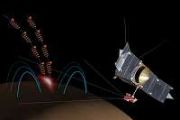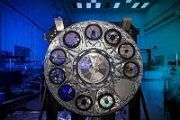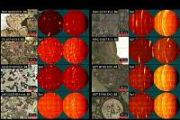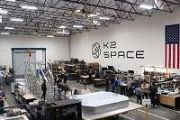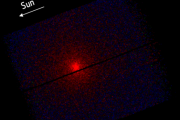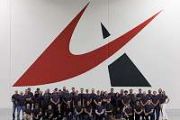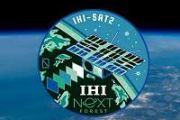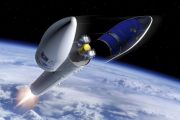
Copernical Team
China sending up next space station crew in June

MetOp-SG-B weather satellite: Scatterometer flies through tests
 The flight model of the Scatterometer Antenna Subsystem (SAS) of the MetOp Second Generation meteorological satellites has been officially delivered after four months of extensive testing at the Airbus facility in Madrid. It will now be transferred to Airbus in Friedrichshafen (Germany) where it will be integrated into the satellite along with the other instruments.
The SAS protoflight mod
The flight model of the Scatterometer Antenna Subsystem (SAS) of the MetOp Second Generation meteorological satellites has been officially delivered after four months of extensive testing at the Airbus facility in Madrid. It will now be transferred to Airbus in Friedrichshafen (Germany) where it will be integrated into the satellite along with the other instruments.
The SAS protoflight mod Hughes announces distribution agreement with OneWeb Technologies
 Hughes Network Systems, LLC (HUGHES), an innovator in satellite and multi-transport technologies and networks for 50 years, has announced it signed a distribution agreement with OneWeb Technologies Inc., a wholly owned subsidiary of OneWeb, to deliver managed Low Earth Orbit (LEO) services to the U.S. Department of Defense (DoD). The agreement follows the launch of the industry's first managed L
Hughes Network Systems, LLC (HUGHES), an innovator in satellite and multi-transport technologies and networks for 50 years, has announced it signed a distribution agreement with OneWeb Technologies Inc., a wholly owned subsidiary of OneWeb, to deliver managed Low Earth Orbit (LEO) services to the U.S. Department of Defense (DoD). The agreement follows the launch of the industry's first managed L Diverse life forms may have evolved earlier than previously thought
 Diverse microbial life existed on Earth at least 3.75 billion years ago, suggests a new study led by UCL researchers that challenges the conventional view of when life began.
For the study, published in Science Advances, the research team analysed a fist-sized rock from Quebec, Canada, estimated to be between 3.75 and 4.28 billion years old. In an earlier Nature paper*, the team found tiny
Diverse microbial life existed on Earth at least 3.75 billion years ago, suggests a new study led by UCL researchers that challenges the conventional view of when life began.
For the study, published in Science Advances, the research team analysed a fist-sized rock from Quebec, Canada, estimated to be between 3.75 and 4.28 billion years old. In an earlier Nature paper*, the team found tiny Oldest evidence of Mayan calendar found in Guatemala
 The oldest evidence of the Maya calendar has been excavated at San Bartolo, Guatemala, found among fragments of painted murals.
Acording to a new study, two fragments with a "7 deer" date notation date to between 300 and 200 BCE, based on radiocarbon dating.
Authors of the study said that the finding "represents a day in the 260-day divinatory calendar used throughout Mesoamerica
The oldest evidence of the Maya calendar has been excavated at San Bartolo, Guatemala, found among fragments of painted murals.
Acording to a new study, two fragments with a "7 deer" date notation date to between 300 and 200 BCE, based on radiocarbon dating.
Authors of the study said that the finding "represents a day in the 260-day divinatory calendar used throughout Mesoamerica Three Chinese astronauts return to Earth after six months in space
 Three Chinese astronauts returned to Earth on Saturday after 183 days in space, ending China's longest crewed mission as it continues its quest to become a major space power.
The Shenzhou-13 spacecraft was the latest mission in Beijing's drive to rival the United States, after landing a rover on Mars and sending probes to the Moon.
Live footage from state broadcaster CCTV showed the caps
Three Chinese astronauts returned to Earth on Saturday after 183 days in space, ending China's longest crewed mission as it continues its quest to become a major space power.
The Shenzhou-13 spacecraft was the latest mission in Beijing's drive to rival the United States, after landing a rover on Mars and sending probes to the Moon.
Live footage from state broadcaster CCTV showed the caps Xi calls on Wenchang to build world-class spaceport
 President Xi Jinping has called on the Wenchang Space Launch Center in the southern island province of Hainan to build itself into a world-class spaceport.
Xi made the remark on Tuesday afternoon as he visited the launch complex, the newest and southernmost of its kind in China.
Xi, who is also general secretary of the Communist Party of China Central Committee and chairman of the Ce
President Xi Jinping has called on the Wenchang Space Launch Center in the southern island province of Hainan to build itself into a world-class spaceport.
Xi made the remark on Tuesday afternoon as he visited the launch complex, the newest and southernmost of its kind in China.
Xi, who is also general secretary of the Communist Party of China Central Committee and chairman of the Ce Shenzhou 13 astronauts ready to return
 China's Shenzhou XIII mission crew have completed all of their tasks and will return to Earth, according to the China Manned Space Agency.
The agency said on Thursday night that the astronauts - Major General Zhai Zhigang, Senior Colonel Wang Yaping and Senior Colonel Ye Guangfu - will leave the Tiangong space station in due course. Their reentry capsule will touch down at the Dongfeng lan
China's Shenzhou XIII mission crew have completed all of their tasks and will return to Earth, according to the China Manned Space Agency.
The agency said on Thursday night that the astronauts - Major General Zhai Zhigang, Senior Colonel Wang Yaping and Senior Colonel Ye Guangfu - will leave the Tiangong space station in due course. Their reentry capsule will touch down at the Dongfeng lan China Satellite Navigation Conference to highlight digital economy, intelligent navigation
 The 13th China Satellite Navigation Conference will be held in Beijing in May, highlighting the digital economy and intelligent navigation, according to the China Satellite Navigation Office.
The conference will showcase the latest industrialization achievement of the BeiDou Navigation Satellite System (BDS), the office said.
Diverse events such as summit forums, academic exchanges,
The 13th China Satellite Navigation Conference will be held in Beijing in May, highlighting the digital economy and intelligent navigation, according to the China Satellite Navigation Office.
The conference will showcase the latest industrialization achievement of the BeiDou Navigation Satellite System (BDS), the office said.
Diverse events such as summit forums, academic exchanges, MAGIC telescopes observe nova explosion
 Light on, light off - this is how one could describe the behavior of the nova, which goes by the name RS Ophiuchi (RS Oph). Every 15 years or so, a dramatic explosion occurs in the constellation of the Serpent Bearer. Birthplaces of a nova are systems in which two very different stars live in a parasitic relationship: A white dwarf, a small, burned-out and tremendously dense star - a teaspoon of
Light on, light off - this is how one could describe the behavior of the nova, which goes by the name RS Ophiuchi (RS Oph). Every 15 years or so, a dramatic explosion occurs in the constellation of the Serpent Bearer. Birthplaces of a nova are systems in which two very different stars live in a parasitic relationship: A white dwarf, a small, burned-out and tremendously dense star - a teaspoon of 
